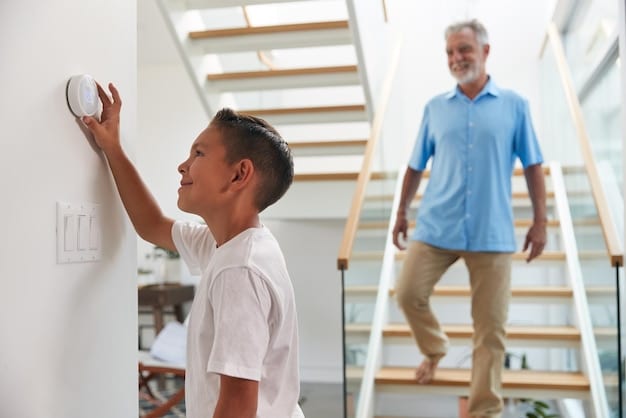Smart Home Emergency Plan: Power Outage & Disaster Guide

A smart home emergency plan helps you prepare for power outages and natural disasters by outlining steps like setting up backup power, securing smart devices, and establishing communication methods.
A smart home emergency plan is crucial for ensuring your safety and the security of your property during unforeseen events. Be ready to ensure a resilient home environment when the unexpected happens.
Why You Need a Smart Home Emergency Plan
Having a well-defined emergency plan is essential in today’s world, especially when you incorporate smart home technology. Unexpected events like power outages, hurricanes, earthquakes, or wildfires can disrupt your life, and a smart home emergency plan ensures your safety and minimizes potential damage.
Provides Peace of Mind
Knowing you have a plan in place can significantly reduce stress and anxiety during emergencies. Everyone in your household will understand their roles and responsibilities, which can lead to quicker and more effective responses.
Protects Your Smart Home Investment
Smart home devices often rely on electricity and internet connectivity. An emergency plan can include measures to protect these devices from power surges, data loss, and physical damage, ensuring they remain functional and secure even after a disaster.

Ensures Continued Safety
Smart devices, such as smart smoke detectors and security systems, provide crucial safety features. A smart home emergency plan ensures these features remain active, often through battery backups or alternative power sources, to safeguard your home and family.
A comprehensive plan is more than just a checklist; it’s a strategy that integrates your smart home technology with traditional emergency preparedness measures. This combination creates a resilient framework for handling emergencies effectively.
Ultimately, a smart home emergency plan is a proactive approach to ensure stability and safety during crises. It’s an investment in your peace of mind, knowing you’re prepared for whatever may come your way.
Assessing Potential Emergency Risks
Before creating your smart home emergency plan, you must identify which types of emergencies are most likely to affect your area. Different regions face different risks, and your plan should be tailored accordingly.
Natural Disasters
Consider the natural disasters that are common in your region. These might include hurricanes, tornadoes, earthquakes, floods, wildfires, or severe winter storms. Each type of disaster requires specific preparation measures.
Power Outages
Power outages can occur due to various reasons, including severe weather, equipment failures, or planned maintenance. Short-term and long-term power loss can affect smart home functions and necessitate backup solutions.
Home Security Threats
- Burglaries: Assess your risk of home intrusion and ensure your smart security systems are equipped with backup power and communication methods.
- Fires: Consider the risk of fires, whether from cooking accidents, faulty wiring, or external sources like wildfires. Make sure your smart smoke detectors are functional and connected.
- Carbon Monoxide Leaks: Ensure you have smart carbon monoxide detectors that can alert you even during a power outage.
Technological Vulnerabilities
Smart home systems can be vulnerable to hacking or system failures. Plan for these scenarios by establishing robust cybersecurity measures and having manual overrides for essential functions.
Understanding your specific risks allows you to prioritize the most critical aspects of your emergency plan, ensuring you’re prepared for the most likely threats.
By considering these risks, you can create a more effective and tailored emergency plan that addresses the specific challenges your smart home might face.
Creating a Smart Home Emergency Checklist
A smart home emergency plan checklist can help you stay organized and ensure you’ve covered all essential steps. This checklist should be a living document that you update periodically as your needs and technology evolve.
Essential Supplies
Having an emergency supply kit is the first step in preparing for any disaster. Ensure your kit includes:
- Water (one gallon per person per day)
- Non-perishable food
- First aid kit
- Flashlights and extra batteries
- Portable power bank for charging devices
Backup Power Solutions
Backup power is vital for maintaining essential smart home functions during a power outage. Evaluate these options:
Battery Backup: Many smart devices, like smoke detectors and security systems, come with battery backups. Check and replace these batteries regularly.
Generator: A generator can power critical appliances and smart home devices during extended outages. Ensure you know how to operate it safely.
Uninterruptible Power Supply (UPS): UPS devices provide temporary power to electronics, allowing you to safely shut down or continue using them for a short period.

Securing Smart Devices
During an emergency, securing your smart devices can prevent damage and protect your data. Here’s how:
Surge Protectors: Use surge protectors to safeguard against power surges when electricity is restored.
Data Backup: Regularly back up data from your smart home hub and other critical devices to prevent data loss.
Communication Plan
Establishing a communication plan is crucial, especially if internet connectivity is lost. Consider these methods:
Emergency Contacts: Keep a list of emergency contacts accessible offline.
Two-Way Radios: Use two-way radios for communication within your household if cell service is unavailable.
Landline Phone: If possible, maintain a landline phone for emergency calls.
By having a detailed checklist, you can efficiently prepare your smart home for any emergency, ensuring every member of your household is aware of their responsibilities and equipped to handle the situation.
Regularly reviewing and updating your checklist ensures it remains relevant and effective, providing ongoing protection and peace of mind.
Integrating Smart Devices into Your Emergency Plan
Consider how you can leverage the capabilities of your smart devices to enhance your smart home emergency plan. Many smart devices offer features that can be invaluable during an emergency.
Smart Lighting
Smart bulbs can be programmed to turn on automatically during a power outage or to flash in different colors to signal specific emergencies, such as a fire or carbon monoxide leak.
Smart Smoke Detectors
Smart smoke detectors not only detect smoke but also send alerts to your smartphone, even when you’re away from home.
Smart Security Systems
Smart security systems can provide continuous monitoring and alerting, even during a power outage, by using battery backups. Systems can integrate with professional monitoring services for faster response times.
Smart Locks
Smart locks can be programmed to automatically unlock in the event of a fire, allowing for quicker evacuation.
Remote Control: Smart thermostats help remotely control the temperature, optimizing energy use and avoiding damage from extreme temperatures.
Integrating your smart devices effectively into your emergency plan requires thoughtful consideration of each device’s capabilities and how they can contribute to your overall safety and preparedness.
This integration can transform your smart home into a proactive safety hub, providing you with real-time information and automated responses during emergencies, ultimately keeping your home and family safer.
Power Outage Specifics
Power outages are a common occurrence, and it’s essential to have specific protocols in your smart home emergency plan to address them effectively. Focusing on power outage specifics ensures your home remains functional and safe.
Backup Power Activation
Know how to activate your backup power sources, whether it’s a generator, battery backup, or UPS. Regularly test these systems to ensure they function correctly.
Disconnecting Sensitive Electronics
Disconnect sensitive electronics from power outlets to protect them from power surges when electricity is restored. This includes smart TVs, computers, and other valuable devices.
Using Smart Plugs
Smart plugs can be used to remotely turn off less critical appliances and devices during a power outage, conserving backup power for essential items.
Conserving Energy
Use smart thermostats to adjust the temperature settings to conserve energy. Lower the thermostat in winter and raise it in summer to minimize power consumption.
- Smart Lighting: Use smart lighting to manage usage efficiently during a power outage.
- Temperature Sensors: Smart sensors help monitor temperature changes inside the refrigerator.
- Window Opening: Open windows to maintain a comfortable temperature indoors.
By having pre-planned steps for power outages, you can minimize the disruption and ensure your smart home continues to function as effectively as possible under the circumstances.
These specific protocols can help mitigate the inconvenience and potential dangers of power outages, keeping your home and family safer and more comfortable.
Regularly Reviewing and Updating Your Plan
A smart home emergency plan is not a one-time task. It requires regular review and updates to ensure it remains effective and relevant. Make it a habit to revisit your plan periodically.
Annual Review
Conduct a comprehensive annual review of your emergency plan. Assess any changes in your household, your environment, and your smart home technology.
Battery Replacements
Check and replace batteries in all your smart devices and backup power systems at least twice a year.
Testing Equipment
Regularly test your backup power sources, such as generators and UPS devices, to ensure they are functioning correctly.
Simulating Emergency Scenarios
Conduct regular drills to simulate emergency scenarios. This will help everyone in your household become familiar with the plan and their roles.
- Smart Lighting Adjustment: Adjust smart light settings to signal different conditions.
- App Updates: Update smart devices apps to prevent technology gaps.
By establishing a routine for reviewing and updating your plan, you ensure it remains a valuable tool in protecting your home and family during emergencies.
Regularly reassessing and refining your emergency plan guarantees it stays aligned with your current needs, technology, and risk factors, providing continuous safety and preparedness.
| Key Point | Brief Description |
|---|---|
| 🚨 Emergency Checklist | Essential supplies, backup power, and security for smart devices. |
| 💡 Smart Devices Integration | Use capabilities of your smart devices during an emergency. |
| 🔋 Power Outage Protocols | Activate backup power and disconnect sensitive electronics. |
| 🔄 Regular Review | Conduct drills, check equipment, evaluate changes. |
FAQ
▼
Include water (one gallon per person per day), non-perishable food, a first aid kit, flashlights & extra batteries, and a portable power bank.
▼
Use surge protectors for all smart devices to prevent damage from power spikes when electricity is restored after an outage.
▼
Keep a list of emergency contacts offline, use two-way radios for local communication, and maintain a landline phone if possible.
▼
Test your backup power systems, like generators and UPS devices, regularly to ensure they are functioning correctly and ready for use.
▼
Drills help everyone become familiar with the emergency plan, their roles, and how to respond quickly and effectively during a real event.
Conclusion
Creating a comprehensive smart home emergency plan is important for ensuring your home’s safety and security during unexpected events. By assessing risks, creating a checklist, integrating smart devices, and regularly reviewing your plan, you can be well-prepared for power outages and natural disasters. Your proactive preparation significantly enhances your home’s resilience and provides peace of mind for you and your family.





